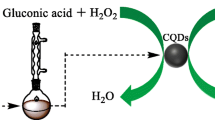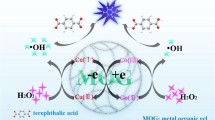Abstract
A method is described for the preparation of copper(II)-modified keratin-capped gold nanoclusters (AuNCs) with adjustable Au/Cu molar ratio through a two-step synthetic route. The introduction of Cu(II) is known to cause quenching of the fluorescence of such AuNCs. It is found, however, that the Cu(II) loaded AuNC (AuNC-Cu2+) display strongly enhanced peroxidase-like activity and improved chemical stability. This is assumed to be due to the synergistic effect of the gold and copper atoms and in contrast to the single components (pure AuNCs and copper ions). The kinetic parameters of the new peroxidase mimic show a higher Kcat value (12.1 × 10−4 s−1) and a lower Km value (53 μM) for H2O2 (compared to those of conventional AuNCs). The catalytic activity is stable and remains essentially unchanged after two months. The interactions of AuNCs with Cu(II) were characterized by fluorescence spectroscopy, UV-vis spectroscopy and X-ray photoelectron spectroscopy. Based on these findings, a glucose colorimetric assay at 452 nm was developed that has a detection range from 1.6 to 800 μM and a 0.26 μM detection limit.

Copper ion-modified keratin-capped gold nanoclusters (AuNC-Cu2+) exhibit enhanced peroxidase-like activity owing to the synergistic effect of the gold and copper atoms which is in contrast to pure AuNCs.





Similar content being viewed by others
References
Lin L, Song X, Chen Y, Rong M, Zhao T, Wang Y, Jiang Y, Chen X (2015) Intrinsic peroxidase-like catalytic activity of nitrogen-doped graphene quantum dots and their application in the colorimetric detection of H2O2 and glucose. Anal Chim Acta 869:89–95
Hu L, Liao H, Feng L, Wang M, Fu W (2018) Accelerating the peroxidase-like activity of gold nanoclusters at neutral pH for colorimetric detection of heparin and heparinase activity. Anal Chem 90:6247–6252
Liu Q, Yang Y, Li H, Zhu R, Shao Q, Yang S, Xu J (2015) NiO nanoparticles modified with 5,10,15,20-tetrakis(4-carboxyl pheyl)-porphyrin: promising peroxidase mimetics for H2O2 and glucose detection. Biosens Bioelectron 64:147–153
Lu N, Zhang M, Ding L, Zheng J, Zeng C, Wen Y, Liu G, Aldalbahi A, Shi J, Song S, Zuo X, Wang L (2017) Yolk-shell nanostructured Fe3O4@C magnetic nanoparticles with enhanced peroxidase-like activity for label-free colorimetric detection of H2O2 and glucose. Nanoscale 9:408–4515
Liao H, Hu L, Zhang Y, Yu X, Liu Y, Li R (2018) A highly selective colorimetric sulfide assay based on the inhibition of the peroxidase-like activity of copper nanoclusters. Microchim Acta 185:143
Amiripour F, Azizi SN, Ghasemi S (2018) Gold-copper bimetallic nanoparticles supported on nano P zeolite modified carbon paste electrode as an efficient electrocatalyst and sensitive sensor for determination of hydrazine. Biosens Bioelectron 107:111–117
Li S, Liu X, Chai H, Huang Y (2018) Recent advances in the construction and analytical applications of metal-organic frameworks-based nanozymes. TrAC Trends Anal Chem 105:391–403
Tran HV, Nguyen TV, Nguyen ND, Piro B, Huynh CD (2018) A nanocomposite prepared from FeOOH and N-doped carbon nanosheets as a peroxidase mimic, and its applacation to enzymatic sensing of glucose in human urine. Microchim Acta 185:270
Wang Q, Wei H, Zhang Z, Wang E, Dong S (2018) Nanozyme: an emerging alternative to natural enzyme for biosensing and immunoassay. TrAC Trends Anal Chem 105:218–224
Wang X, Wu Q, Shan Z, Huang Q (2011) BSA-stabilized Au clusters as peroxidase mimetics for use in xanthine detection. Biosens Bioelectron 26:3614–3619
Jiang X, Sun C, Guo Y, Nie G, Xu L (2015) Peroxidase-like activity of apoferritin paired gold clusters for glucose detection. Biosens Bioelectron 64:165–170
Wang Y, Tang S, Yang H, Song H (2016) A novel colorimetric assay for rapid detection of cysteine and Hg2+ based on gold clusters. Talanta 146:71–74
Liu Y, Liu X, Yang S, Li F, Shen C, Huang M, Li J, Nasaruddin RR, Xie J (2018) Rational design of high-performance continuous-flow microreactors based on gold nanoclusters and graphene for catalysis. ACS Sustain Chem Eng 6:15425–15433
Li J, Jing L, Liu Z, Yuan T, Liu X, Wang F (2017) Detecting proteins glycosylation by a homogeneous reaction system with zwitterionic gold nanoclusters. Anal Chem 89:943–951
Wang J, Ma S, Ren J, Yang J, Qu Y, Ding D, Zhang M, Yang G (2018) Fluorescence enhancement of cysteine-rich protein-templated gold nanoclusters using silver(I) ions and its sensing application for mercury(II). Sensors Actuators B Chem 267:342–350
Qin L, He X, Chen L, Zhang Y (2015) Turn-on fluorescent sensing of glutathione S-transferase at near-infrared region based on fret between gold nanoclusters and gold nanorods. ACS Appl Mater Interfaces 7:5965–5971
Lin Y, Ren J, Qu X (2014) Nano-gold as artificial enzymes: hidden talents. Adv Mater 26:4200–4217
Cho S, Shin HY, Kim MI (2017) Nanohybrids consisting of magnetic nanoparticles and gold nanoclusters as effective peroxidase mimics and their application for colorimetric detection of glucose. Biointerphases 12:01A401
Veith GM, Lupini AR, Rashkeev S, Pennycook SJ, Mullins DR, Schwartz V, Bridges CA, Dudney NJ (2009) Thermal stability and catalytic activity of gold nanoparticles supported on silica. J Catal 262:92–101
Lv H, Li Y, Zhang X, Gao Z, Zhang C, Zhang S, Dong Y (2018) Enhanced peroxidase-like properties of Au@Pt DNs/NG/Cu2+ and application of sandwich-type electrochemical immunosensor for highly sensitive detection of CEA. Biosens Bioelectron 112:1–7
Nirala NR, Tiwari M, Prakash R (2018) A nanoporous palladium(II) bridged coordination polymer acting as a peroxidase mimic in a method for visual detection of glucose in tear and saliva. Microchim Acta 185:245
Khataee A, Irani-nezhad M, Hassanzadeh J (2018) Improved peroxidase mimetic activity of a mixture of WS2 nanosheets and silver nanoclusters for chemiluminescent quantification of H2O2 and glucose. Microchim Acta 185:190
Tao Y, Lin Y, Huang Z, Ren J, Qu X (2013) Incorporating graphene oxide and gold nanoclusters: a synergistic catalyst with surprisingly high peroxidase-like activity over a broad pH range and its application for cancer cell detection. Adv Mater 25:2594–2599
Feng J, Huang P, Wu F (2017) Gold–platinum bimetallic nanoclusters with enhanced peroxidase-like activity and their integrated agarose hydrogel-based sensing platform for the colorimetric analysis of glucose levels in serum. Analyst 142:4106–4115
Chen Y, Qiao J, Liu Q, Zhang M, Qi L (2018) Fluorescence turn-on assay for detection of serum D-penicillamine based on papain@AuNCs-Cu2+ complex. Anal Chim Acta 1026:133–139
Kong L, Chu X, Ling X, Ma G, Yao Y, Meng Y, Liu W (2016) Biocompatible glutathione-capped gold nanoclusters for dual fluorescent sensing and imaging of copper(II) and temperature in human cells and bacterial cells. Microchim Acta 183:2185–2195
Saito H, Nosaka Y (2015) Enhancement of the generation of photocatalytic active species by loading copper ions on gold-nanoparticle-deposited titanium dioxide. Catal Commun 61:117–120
Zhao Y, Qiang H, Chen Z (2016) Colorimetric determination of Hg(II) based on a visually detectable signal amplification induced by a Cu@Au-Hg trimetallic amalgam with peroxidase-like activity. Microchim Acta 184:107–115
Chen W-H, Vázquez-González M, Kozell A, Cecconello A, Willner I (2018) Cu2+-modified metal-organic framework nanoparticles: a peroxidase-mimicking nanoenzyme. Small 14(5):1703149
Vázquez-González M, Liao WC, Cazelles R, Wang S, Yu X, Gutkin V, Willner I (2017) Mimicking horseradish peroxidase functions using Cu2+-modified carbon nitride nanoparticles or Cu2+-modified carbon dots as heterogeneous catalysts. ACS Nano 11:3247–3253
Wang S, Cazelles R, Liao WC, Vázquez-González M, Zoabi A, Abu-Reziq R, Willner I (2017) Mimicking horseradish peroxidase and nadh peroxidase by heterogeneous Cu2+-modified graphene oxide nanoparticles. Nano Lett 17:2043–2048
Group TAC (2008) Intensive blood glucose control and vascular outcomes in patients with type 2 diabetes. New Engl J Med 358:2560–2572
Xing Y, Zhao D, Gu T, Liu HL, Yu WD (2017) Highly efficient fluorescence probe for copper (II) ions based on gold nanoclusters supported on wool keratin. J Mater Sci 53:4056–4066
Kim M, Na H, Lee KC, Yoo EA, Lee M (2003) Preparation and characterization of au–ag and au–cu alloy nanoparticles in chloroform. J Mater Chem 13:1789–1792
Huang H, Li H, Feng J, Feng H, Wang A, Qian Z (2017) One-pot green synthesis of highly fluorescent glutathione-stabilized copper nanoclusters for Fe3+ sensing. Sensors Actuators B Chem 241:292–297
Acknowledgements
This work was financially supported by National Natural Science Foundation of China (Grants 21806103 and 21601121).
Author information
Authors and Affiliations
Corresponding authors
Ethics declarations
The author(s) declare that they have no competing interests.
Additional information
Publisher’s note
Springer Nature remains neutral with regard to jurisdictional claims in published maps and institutional affiliations.
Electronic supplementary material
ESM 1
(DOCX 1.87 mb)
Rights and permissions
About this article
Cite this article
Ma, S., Wang, J., Yang, G. et al. Copper(II) ions enhance the peroxidase-like activity and stability of keratin-capped gold nanoclusters for the colorimetric detection of glucose. Microchim Acta 186, 271 (2019). https://doi.org/10.1007/s00604-019-3395-8
Received:
Accepted:
Published:
DOI: https://doi.org/10.1007/s00604-019-3395-8




